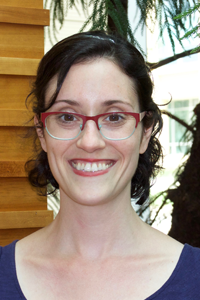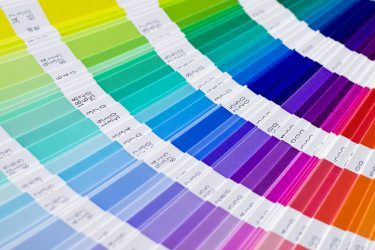
Karen Schloss is the newest addition to the Living Environments Laboratory theme at WID. She was previously located at Brown University where she was the Principal Investigator at the Visual Perception and Cognition Lab. As Schloss unpacked her office at WID, we inquired about her Tools for Discovery.
What do you work on?
My main interest is on discovering how colors influence the way people think, feel, and behave. Colors are fascinating because they can be applied to the surfaces of objects to communicate a rich network of information. This is why colors are successful at sending signals in nature (e.g., whether food is edible or poisonous) and in the human-made environment (e.g., whether to stop or go when driving, whether a product was produced by Brand A or Brand B).
Understanding how colors communicate information is complicated because the same color can mean different things depending on the context. For example, in nature, redness in foods can signal ripeness (e.g., tomatoes, strawberries) or danger (e.g., toadstools and poppies), and redness in human skin can signal pleasure or anger. This problem is even more complex in modern human societies because the colors of artifacts, which might seem arbitrary, are used to communicate abstract concepts (e.g., group/brand identity, object categories, and patterns in datasets). As a result, red in human societies not only signals the edibility of food and the emotionality of faces, it also signals the University of Wisconsin – Madison, the Republican Party, Communism, the Boston Red Sox, Target stores, and brain activation in neuroimaging. Across different contexts, the same color can activate wildly different thoughts and emotional responses in observers.
My previous research primarily focused on how the associations people have with colors influence color preferences and interpretations of data visualizations. As an Assistant Professor in the Wisconsin Institute for Discovery – Living Environments Lab (LEL) and in the Department of Psychology, I plan to build on this work to discover how color can help people interpret and navigate rich 3D environments. I use the term “environment” broadly to include any space an observer can enter and explore, ranging from traditional homes and cities to 3D models of brains, molecules, and other kinds of biological or mechanical systems. I also plan to investigate how colors influence people’s aesthetic and emotional experiences in these environments.
What are your tools for analysis?
My first tool for analysis observation. I notice how colors occur in natural environments and are used in human-made environments, tools, signs, and symbols. I then work with my collaborators and students to form hypotheses about what makes certain colors more/less effective or preferable and to conduct experiments with human participants to test those hypotheses. In the past I have used Presentation, Psychtoolbox in MATLAB, and Qualtrics to present experiment stimuli on computer monitors or in the Oculus Rift. I am excited to learn how to use the tools the LEL is currently working with to render 3D immersive environments across a variety of platforms, including the Vive and the CAVE. I analyze data using MATLAB and SPSS and make data visualizations in MATLAB and Adobe Illustrator. Each experiment typically sparks a series of several other observations and questions, which perpetuate the research cycle.
“I shut out the world with my turquoise headphones playing a Pandora station and type away.”
-Karen Schloss
Tools for writing?
I am a big fan of old-school yellow pencils (that need to be sharpened by hand), colorful markers to help color-code ideas, scrap paper, index cards, and outlines. I like to organize my thoughts before typing into a Word document so that the writing process can be organized and deliberate. Sometimes this requires stepping away from all technology and going for a walk or laying on the floor and looking up at the ceiling. Once I start writing I shut out the world with my turquoise headphones playing a Pandora station and type away. When writing with collaborators, we iterate over many versions using track changes. I think it is important to promote a writing culture in which it is ok to share half-baked sketches of ideas and iterate to refine them, rather than feel like each shared version must be clean and polished.
Tools for collaboration?
I find that communication is a key tool for collaboration. Collaborations often start by sharing new data or posing problems to students or colleagues, which spark discussions about new research questions. Sometimes these exchanges place during formal settings (e.g., conference presentations and colloquia), and other times they arise from casual and even social interactions (e.g., walks to get coffee). In my collaborations it has been important to have frequent meetings to brainstorm, problem-solve, and share results, either in person or over Skype/Google Hangout. When not in the same room, my collaborators and I use screen share technology to go over code, datasets, and figures.
Your ultimate tool for discovery?
Questions are my ultimate tool for discovery. One of the most challenging parts of research is formulating new, testable research questions, which are currently unanswered but can be addressed with current methods or by developing novel methods. Questions are catalysts that spark experiment design, data collection, and analysis, which lead to new discoveries and new theories about how the mind works.
-curated by Patricia Pointer


You must be logged in to post a comment.